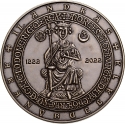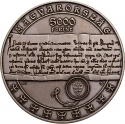You are about to finish your registration. Please check your mailbox (including spam folder). There should be a letter with a confirmation link. Check setting to make sure that your e-mail address is correct.
Send letter againDescription
To commemorate the 800th anniversary of the issuance of the Golden Bull, the Magyar Nemzeti Bank has released special commemorative coins. These coins have face values of 10,000 HUF in mini gold and 5,000 HUF in colored metal, matching the size of the original Golden Bull seal. The gold coin can be attached to the front of the colored metal coin, symbolizing the seal, though both can be appreciated individually.
The Golden Bull of 1222, issued by King Andrew II of Hungary, was a landmark edict that imposed constitutional limits on royal power, making it one of the earliest examples of such constraints in Europe. Compelled by his nobles, Andrew II accepted the Golden Bull at the 1222 Diet of Fehérvár. The edict established the rights of the Hungarian nobility, including the right to resist the king if he acted unlawfully (jus resistendi). It exempted the nobles and the church from taxes, prohibited forced participation in wars outside Hungary, and ensured the principle of equality among the nobility. Seven copies of the Golden Bull were made for various significant entities, including the Pope and the Knights Templar.
The creation of the Golden Bull was driven by the rise of a middle-class nobility in Hungary's feudal system. King Andrew II's frequent property donations to loyal servants elevated their economic and social status, altering the nation's class structure. To ease tensions between the hereditary nobles and the emerging middle-class nobility, Andrew issued the Golden Bull of 1222. This document is often compared to England's Magna Carta, as both served as foundational constitutional charters in their respective nations.
Engraver: Zoltán Endrődy
Obverse

|
Depicts a modern rendition of the monarch depiction on the original seal of the Golden Bull. To the left of the depiction is the year of the issuance of the Golden Bull, "1222", and to the right, the year of issuance of the commemorative coin and the 800th anniversary of the issuance of the Golden Bull, "2022", with the "BP." mintmark below. Along the edge of the reverse side, separated by a cross motif each, the inscription "ANDREW II" above and "GOLDEN BULL" below is depicted in a semicircular arrangement. At the bottom edge, the engraver's privy mark is placed on the left. + II. ANDRÁS + |
|---|---|
Reverse

|
Depicts a modern representation of the coat of arms exclusively used on the original seal of the Golden Bull. Along the edge, in a semicircular inscription, between motifs of dots and crosses, the inscription "HUNGARY" is depicted, with the value indication and the inscription "FORINT" separated below by a motif of dots and crosses. •+• MAGYARORSZÁG •+• |
| Edge |
Related coins
800th Anniversary of the Golden Bull of King Andrew II



